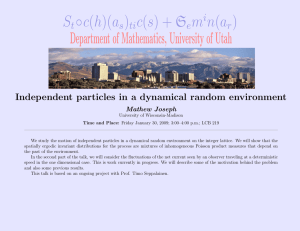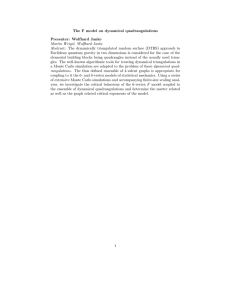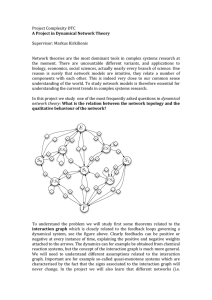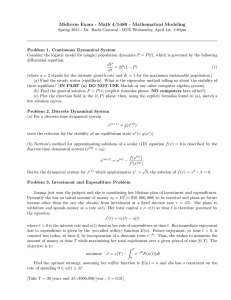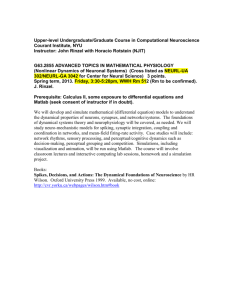Learning Dynamic Policies from Demonstration
advertisement
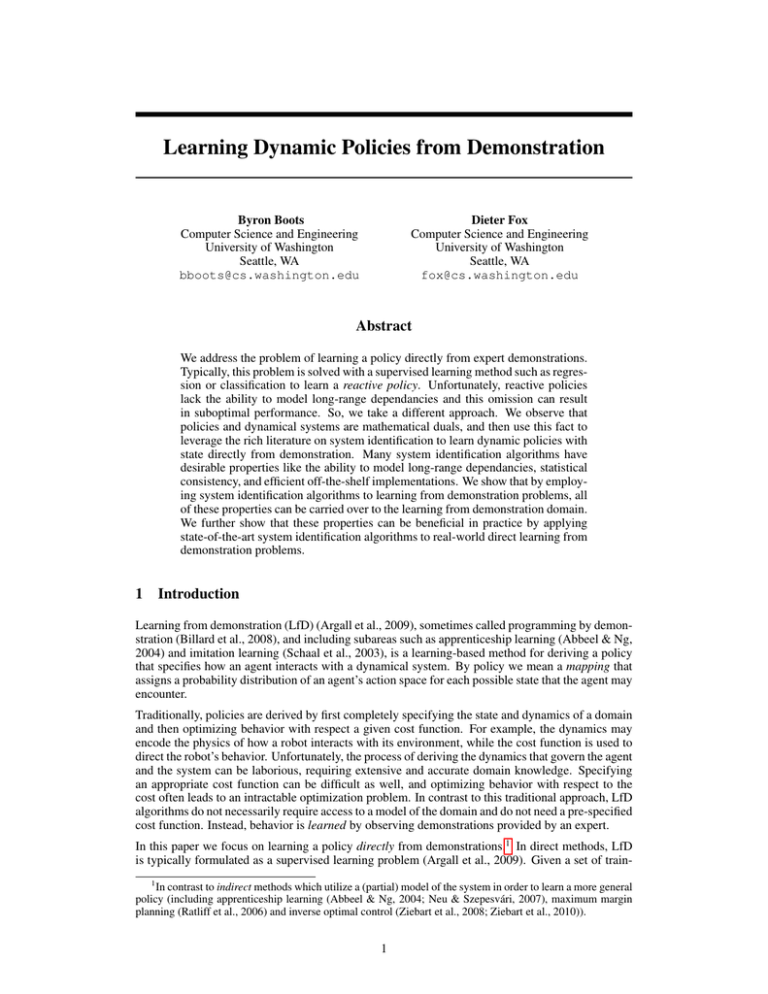
Learning Dynamic Policies from Demonstration
Dieter Fox
Computer Science and Engineering
University of Washington
Seattle, WA
fox@cs.washington.edu
Byron Boots
Computer Science and Engineering
University of Washington
Seattle, WA
bboots@cs.washington.edu
Abstract
We address the problem of learning a policy directly from expert demonstrations.
Typically, this problem is solved with a supervised learning method such as regression or classification to learn a reactive policy. Unfortunately, reactive policies
lack the ability to model long-range dependancies and this omission can result
in suboptimal performance. So, we take a different approach. We observe that
policies and dynamical systems are mathematical duals, and then use this fact to
leverage the rich literature on system identification to learn dynamic policies with
state directly from demonstration. Many system identification algorithms have
desirable properties like the ability to model long-range dependancies, statistical
consistency, and efficient off-the-shelf implementations. We show that by employing system identification algorithms to learning from demonstration problems, all
of these properties can be carried over to the learning from demonstration domain.
We further show that these properties can be beneficial in practice by applying
state-of-the-art system identification algorithms to real-world direct learning from
demonstration problems.
1
Introduction
Learning from demonstration (LfD) (Argall et al., 2009), sometimes called programming by demonstration (Billard et al., 2008), and including subareas such as apprenticeship learning (Abbeel & Ng,
2004) and imitation learning (Schaal et al., 2003), is a learning-based method for deriving a policy
that specifies how an agent interacts with a dynamical system. By policy we mean a mapping that
assigns a probability distribution of an agent’s action space for each possible state that the agent may
encounter.
Traditionally, policies are derived by first completely specifying the state and dynamics of a domain
and then optimizing behavior with respect a given cost function. For example, the dynamics may
encode the physics of how a robot interacts with its environment, while the cost function is used to
direct the robot’s behavior. Unfortunately, the process of deriving the dynamics that govern the agent
and the system can be laborious, requiring extensive and accurate domain knowledge. Specifying
an appropriate cost function can be difficult as well, and optimizing behavior with respect to the
cost often leads to an intractable optimization problem. In contrast to this traditional approach, LfD
algorithms do not necessarily require access to a model of the domain and do not need a pre-specified
cost function. Instead, behavior is learned by observing demonstrations provided by an expert.
In this paper we focus on learning a policy directly from demonstrations.1 In direct methods, LfD
is typically formulated as a supervised learning problem (Argall et al., 2009). Given a set of train1
In contrast to indirect methods which utilize a (partial) model of the system in order to learn a more general
policy (including apprenticeship learning (Abbeel & Ng, 2004; Neu & Szepesvári, 2007), maximum margin
planning (Ratliff et al., 2006) and inverse optimal control (Ziebart et al., 2008; Ziebart et al., 2010)).
1
ing examples (demonstrated sequences of actions and observations), LfD attempts to learn a reactive policy that maps the previous k observations to an action distribution that mimics the expert’s
demonstration. Depending on whether the actions are discrete or continuous, LfD may be formulated
as a regression or as a classification problem. There have been a number of successful applications
of this approach in robotics. For example, ALVINN (Autonomous Land Vehicle in a Neural Network) (Pomerleau, 1988) used artificial neural networks to learn a mapping from features of camera
images to car steering angles from human demonstrated behavior. And, Ross et al. (Ross et al.,
2012) used linear regression to learn a controller that maps features of images to steering commands
for a micro aerial vehicle (MAV).
Despite these successful examples, it is not difficult to see that such reactive policies are limited in
their expressivity. In the general case, a policy maintains a posterior distribution of actions at conditioned on the entire history of previous observations and actions ht = {o1 , a1 , . . . ot−1 , at−1 , ot }
up to time t; e.g. P[at | ht ]. Reactive policies, based on a truncated length-k history typically miss
important long-term dependancies in the data. Dynamic models correct this problem by assuming a
latent state zt that captures all of the predictive information contained in ht . A policy with a latent
state does not have to condition on the entire history P[at | ht ], but only its state representation
P[at | zt ]. Latent state dynamic models have been used in a wide range of applications including
time series forecasting, statistics, economics, robotics, and control.
In this work we consider the problem of learning dynamic policies directly from demonstrations. We
only assume access to sequences of actions and partial-observations from demonstrated behavior; we
do not assume any knowledge of the environment’s state or dynamics. The goal is to learn a policy
that mimics an expert’s actions.
In contrast to previous work, we do not restrict the learning problem to reactive policies, but instead learn dynamic policies with internal state that capture long-range dependancies in the data.
In order to learn such policies, we identify LfD with the problem of learning a dynamical model.
Specifically, we show that dynamical systems and policies can be viewed as mathematical duals
with similar latent variable structure; a fact which is greatly beneficial for LfD. The duality means
that we can draw on a large number of dynamical system identification algorithms in order to learn
dynamic policies. Many of these algorithms have desirable theoretical properties like unbiasedness
and statistical consistency, and have efficient off-the-shelf implementations. We perform several
experiments that show that system identification algorithms can provide much greater predictive accuracy compared with regression and classification approaches. To the best of our knowledge, this
is the first work to leverage the extensive literature on dynamical system learning for direct LfD.
2
System-Policy Duality
The key insight in this work is that the problem of learning a model of a dynamical system is dual
to the problem of learning a dynamic policy from demonstration.
Consider the graphical model depicting the interaction between a policy and dynamical system in
Figure 1. A generative dynamical system has a latent state that takes actions as input and generates
observations as output at each time step. In such a model the observation distribution at time t
is given by P[ot | a1 , o1 , . . . , at−1 , ot−1 , at ]. In this case, we usually assume a latent variable xt
such that P[ot | a1 , o1 , . . . , at−1 , ot−1 , at ] = P[ot | xt ]. A policy has the same graphical structure
with the actions and observations reversing roles: a latent state that takes observations as inputs and
generates actions as output at each time step. In such a model the action distribution at time t is
given by P[at | o1 , a1 , . . . , ot−1 , at−1 , ot ]. The similarity between the system and policy suggests a
number of dualities. Simulating observations from a dynamical system is dual to sampling an action
from a stochastic policy. Predicting future observations from a dynamical system model is dual to
activity forecasting (Kitani et al., 2012) from a policy. Finally, and most importantly in the context
of this work, learning a policy from demonstration is dual to dynamical system identification. We
summarize the dualities here for convenience:
Dynamical System
↔
Policy
Simulation
↔
Policy Execution
Observation Prediction/Forcasting ↔
Activity Forcasting
Dynamical System Identification ↔ Learning From Demonstration
To make these dualities more concrete, we consider the problem of linear quadratic Gaussian control.
2
A.
B.
system
x t -1
xt
at -1
ot −1
at
ot
at +1
ot +1
x t+1
C.
zt
ot −1
at
ot
at +1
ot +1
at +2
observations
z t -1
xt
x t+1
actions
at -1
x t -1
z t -1
zt
z t+1
z t+1
ot -1
policy
at
ot
at+1
ot +1
at +2
Figure 1: System-Policy Duality. (A) Graphical model depicts the complete interaction between
the a policy with a state zt and a dynamical system with state xt . Considering the system and the
policy independently, we see that they have the same graphical structure (an input-output chain).
(B) The system receives actions as inputs and produces observations as outputs. (C) Conversely,
the policy receives observations as inputs and produces actions as outputs. The similar graphical
structure between the system and policy suggests a number of dualities that can be exploited to
design efficient learning algorithms. See text for details.
2.1
Example: Linear Quadratic Gaussian Control
Consider the following simple linear-Gaussian time-invariant dynamical system model, the steadystate Kalman filter with actions at , observations ot and latent state xt :
xt+1 = As xt + Bs at + Ks et
ot = C s x t
(1)
(2)
Here As is the system dynamics matrix, Bs is the system input matrix, Cs is the system output
matrix, Ks is the constant Kalman gain, and et = ot − Cxt is the innovation.
Given a quadratic input cost function R and the quadratic infinite-horizon state-value function V ∗ ,
the optimal control law is given by
at = −(R + Bs> V ∗ Bs )−1 Bs> V ∗ As xt
= −Lxt
(3)
(4)
where L = (R +Bs> V ∗ Bs )−1 Bs> V ∗ As , found by solving a discrete time Riccati equation, is called
the constant control gain (Todorov, 2006). In other words, the optimal control at is a linear function
−L of the system state xt .
The Policy as a Dynamic Model If we rewrite the original system as
xt+1 = As xt + Bs at + Ks et
= As xt + Bs at + Ks (ot − Cxt )
= (As − Ks Cs )xt + Bs at + Ks ot
= ((As − Ks Cs ) − Bs L) xt + Ks ot + Bs (at + Lxt )
(5)
and then substitute
Ac := (As − Ks Cs ) − Bs L
Bc := Ks
Cc := −L
Kc := Bs
vt := (at − Cc xt )
(6)
then we see that
xt+1 = Ac xt + Bc ot + Kc vt
at = Cc xt
(7)
(8)
In other words, it becomes clear that the policy can be viewed as a dynamic model dual to the
original dynamical system in Eqs. 1 and 2. Here the environment chooses an observation and the
controller generates an action. We assume the action produced may be affected by stochasticity in
the control, so, when we observe the action that was actually generated, we condition on that action.
3
The Policy as a Subsystem In many cases, the policy may be much simpler than the dynamics
of the system. Intuitively, the dynamical system is a full generative model for what may be quite
complex observations (e.g. video from a camera (Soatto et al., 2001; Boots, 2009)). However,
expert demonstrations may only depend on some sub-manifold of the state in the original dynamical
system. Examples of this idea include belief compression (Roy et al., 2005) and value-directed
compression of dynamical systems (Poupart & Boutilier, 2003; Boots & Gordon, 2010).
We can formalize this intuition for linear quadratic Gaussians. Information relevant to the controller
lies on a linear subspace of the dynamical system when the system state can be exactly projected
onto a subspace defined by an orthonormal compression operator V > ∈ Rn×m , where n ≤ m, and
still generate exactly the same output. That is iff
Cc xt ≡ Cc V V > xt
(9)
Given the system in Eqs. 7 and 8, this subsystem will have the form:
V > xt+1 = V > Ac V V > xt + V > Bc ot + V > Kc vt
(10)
>
at = Cc V V xt
(11)
We can now replace
zt := V > xt
Ãc := V > Ac V
B̃c := V > Bc
C̃c := Cc V
K̃c vt
(12)
Substituting Eq. 12 into Eqs. 10 and 11, we get can parameterize the dynamic policy in terms of the
policy state directly
zt+1 = Ãc zt + B̃c ot + K̃c vt
at = C̃c zt
(13)
(14)
Direct Policy Learning Learning from demonstration in the LQG domain normally entails executing a sequence of learning algorithms. First, system identification is used to learn the parameters
of the system in Eqs. 1 and 2. Next, IOC can be used to approximate the cost and value functions V ∗
and R. Finally, these value functions together with Eq. 3 find the optimal control law. To execute the
controller we would filter to find the current estimate of the state x̂t and then calculate ut = −Lx̂t .
Unfortunately, error in any of these steps may propagate and compound in the subsequent steps
which leads to poor solutions. The problem can be mitigated somewhat by first learning the dynamical system model in Eqs. 1 and 2, and then applying linear regression to learn the control law
directly. However, in the event that the policy only lies on a subspace of the original system state
space, we are wasting statistical effort learning irrelevant dimensions of the full system.
Given the system-controller duality of Eqs. 1 and 2 and Eqs. 7 and 8, we suggest an alternative
approach. We directly learn the controller in Eqs. 13 and 14 via system identification without first
learning the dynamical system or performing IOC to learn the cost and value functions. We use
precisely the same algorithm that we would use to learn the system in Eqs. 1 and 2, e.g. N4SID (Van
Overschee & De Moor, 1996), and simply switch the role of the actions and observations.
We can use a similar strategy to directly learn dynamic policies for other dynamical system models
including POMDPS and predictive state representations. Furthermore, unbiasedness and statistical
consistency proofs for system identification will continue to hold for the controller, guaranteeing
that the predictive error in the controller decreases as the quantity of training data increases. In fact,
controller error bounds, which are dependent on the dimensionality of the controller state, are likely
to be tighter for many polcies.
3
Learning From Demonstration as System Identification
Given the dualities between dynamical systems and policies, a large set of tools and theoretical
frameworks developed for dynamical system learning can be leveraged for LfD. We list some of
these tools and frameworks here:
4
• Expectation Maximization for learning linear Gaussian systems and Input-Output
HMMs (Bengio & Frasconi, 1995; Ghahramani, 1998; Roweis & Ghahramani, 1999)
• Spectral learning (subspace identification) for learning linear Gaussian systems, InputOutput HMMs, and Predictive State Representations (Van Overschee & De Moor, 1996;
Katayama, 2005; Hsu et al., 2009; Boots et al., 2010; Boots & Gordon, 2011)
• Nonparametric Kernel Methods for learning very general models of dynamical systems
(Gaussian processes (Ko & Fox, 2009), Hilbert space embeddings (Song et al., 2010; Boots
& Gordon, 2012; Boots et al., 2013))
From a theoretical standpoint, some of these algorithms are better than others. In particular, several
spectral and kernel methods for system identification have nice theoretical properties like statistical
consistency and finite sample bounds. For example, subspace identification for linear Gaussian systems is numerically stable and statistically consistent (Van Overschee & De Moor, 1996). Boots et
al. (Boots et al., 2010; Boots & Gordon, 2011) has developed several statistically consistent learning
algorithms for predictive state representations and POMDPs. And Boots et al. have developed statistically consistent algorithms for nonparametric dynamical system models based on Hilbert space
embeddings of predictive distributions (Song et al., 2010; Boots et al., 2013).
Bias & DAgger Unfortunately, direct LfD methods, including the policy learning methods proposed here, do have a drawback. Samples of demonstrations used to learn policies can be biased
by the expert’s own behavior. This problem has been recognized in previous direct policy learning
applications. For example, both the autonomous car policy parameterized by ALVINN (Pomerleau,
1988) and reactive policy for the micro aerial vehicle in Ross et al. are imperfect and occasionally
move the vehicles closer to obstacles than in any of the training demonstrations (Ross et al., 2012).
Because the vehicle enters into a state not observed in the training data, the learned policy does not
have the ability to properly recover.
Ross et al. has suggested a simple iterative training procedure called data aggregation (DAgger) for
this scenario (Ross et al., 2011). DAgger initially trains a policy that mimics the expert’s behavior
on a training dataset. The policy is then executed, and, while the policy executes, the expert demonstrates correct actions in newly encountered states. Once the new data is collected, the policy is
relearned to incorporate this new information. This allows the learner to learn the proper recovery
behavior in new situations. The process is repeated until the policy demonstrates good behavior.
After a sufficient number of iterations, DAgger is guaranteed to find a policy that mimics the expert
at least as well as a policy learned on the aggregate dataset of all training examples (Ross et al.,
2011).
Although DAgger was originally developed for reactive policy learning, DAgger can also be applied
to system identification (Ross & Bagnell, 2012), and, therefore to any system identification method
that we use to learn a dynamic policy.
4
Empirical Evaluations
We compared a number of different approaches to direct policy learning in two different experimental domains. In the first experiment we looked at the problem of learning a policy for controlling
a slotcar based on noisy readings from an inertial measurement unit. In the second experiment we
looked at the problem of learning a policy that describes the navigation behavior of the Manduca
Sexta, a type of hawkmoth.
4.1
Slotcar Control
We investigate the problem of learning a slotcar control policy from demonstration. The demonstrated trajectories consisted of continuous actions corresponding to the velocity of the car and continuous measurements from an inertial measurement unit (IMU) on the car’s hood, collected as the
car raced around the track. Figure 2(A) shows the car and attached 6-axis IMU (an Intel Inertiadot),
as well as the 14m track. An optimal policy was demonstrated by a robotic system using an overhead
camera to track the position of the car on the track and then using the estimated position to modulate
the speed of the car. Our goal was to learn a policy similar to the optimal policy, but based only on
information from previous actions and IMU observations.
5
A.
B. 40
D.
RMSE
20
Racetrack
0
−20
Inertial Measurement
Unit
−40
0
500
1000
Mean
−20
HSE-PSR
0
Kernel Regression
20
Ridge Regression
Slot Car
Subspace Identification
−40
C. 40
Figure 2: The slotcar experiment. (A) The platform: the experimental setup consisted of a 14m
racetrack and a slotcar with an IMU attached to the hood. (B) Even though the track is topologically
circular and the policy is repetitive, the car experiences significant imprecision in its movement,
especially when traveling at high speeds. This means that simple replay cannot be used to control
the car. The black line indicates the current control signal to the car. The green line indicates a
replayed control signal. The error in car movement causes the two signals to become increasingly
decoupled over time. (C) The predicted action from the best learned policy (the HSE-PSR model).
The red line indicates the learned policy and the black line indicates the true policy. (D) Comparison
of several different direct LFD approaches on the slotcar dataset. Mean is a baseline consisting
of the average action. Ridge regression and kernel regression were used to learn reactive policies.
Subspace identification and the nonparametric HSE-PSR method produce dynamic policies.
We collected the estimated angular velocity of the car (observations) from the IMU as well as the
control input (a number between 0 and 255) at 10Hz for 5000 steps. The first 2500 data points were
used for training and the second 2500 data points were held out for testing. We compared several
different methods for learning a policy. First, we learned two reactive policies that map the preceding action and observation to the next action: a linear policy via ridge regression and a nonlinear
policy via kernel regression. We then learned two dynamic policies using system identification. We
learned a linear Gaussian system by subspace identification (Van Overschee & De Moor, 1996) and
a nonparametric dynamical system via Hilbert space embeddings of predictive state representations
(HSE-PSRs) (Boots et al., 2013).
The four methods were compared on the test dataset by evaluating the expected action from the
learned policies to the actual action executed by the optimal policy. As mentioned above, the reactive methods predicted the next action based solely on the previous action and observation. The
two dynamic policies, however, had a latent state and were updated at each time step by filtering
the previous action and observation. A comparison of the four approaches is given in Figure 2(D).
As expected, the two policies learned by system identification are able to produce better predictions
than their reactive counterparts due the ability to model long-range dependancies in the data. Additionally, we note that the nonparametric HSE-PSR policy performed much better than the linear
policy learned by subspace identification.
4.2
Hawkmoth Behavior Modeling
In the second experiment, we investigate the problem of learning a control policy that mimics
the behavior of the hawkmoth Manduca sexta. M. sexta is large moth that is active in lowlight environments, making it especially well suited to laboratory vision experiments. M. sexta
is also amenable to tethering and has been extensively used in previous tethered flight experiments
(e.g. (Gra, 2002), (Dyhr et al., 2012)). In our navigation experiments, we used a virtual flight arena
similar to that described in (Sponberg & Daniel, 2012), in which a M. sexta hawkmoth is attached
by means of a rigid tether to a single-axis optical torquemeter (Figure 3). The torquemeter measures
the left-right turning torque exerted by the flying moth in response to a visual stimulus projected
6
C.
0
−3
0
Predicted Actions vs. True Actions
1000
HSE-PSR
HSE-PSR
Subspace Identification
Field of View
Trajectory & Pose
Kernel Regression
D. 3
RMSE
Ridge Regression
Hawk Moth
Demonstrated Trajectories
& Environment
B.
E.
Mean
A.
Figure 3: Hawkmoth experiment. (A) The hawkmoth suspended in the simulator. (B) Overhead
view of the paths taken by the hawkmoth through the simulated forest. The two red paths were
used as training data. The blue path was holdout as test data. (C) The position of the moth in
the environment and the corresponding moth field of view. (D) The predicted action from the best
learned policy (the HSE-PSR model). The blue line indicates the action predicted by the learned
policy and the red line indicates the true actions taken by the moth. (E) Comparison of several
different direct LFD approaches on the hawkmoth dataset. The nonparametric HSE-PSR model is
the only approach that is able to learn a reasonably good policy.
onto a curved screen placed in front of it. The left-right turning torque was used to control the visual
stimulus in closed-loop.
Each visual stimulus consisted of a position-dependent rendered view of a virtual 3-D world meant
to look abstractly like a forest. In the simulated world, the moths began each trial in the center
of a ring-shaped field of cylindrical obstacles. For every trial, the moth flew for at least 30s at a
fixed flight speed and visibility range. The rendered images presented to the moth and the resulting
actions (the rotation of the moth, computed from the torque) were recorded. Our goal was to learn a
policy that mimicked the moth behavior, taking images as input and producing rotation as output.
We collected 3 trials of M. sexta flight (Figure 3(B)). The first two trials were used for training
and the last trial was held out for testing. As in the slot car experiment, we evaluated four different
methods for learning a policy: ridge regression, kernel regression, subspace identification, and HSEPSRs. The four methods were compared on the test dataset by evaluating the expected action from
the learned policies to the actual action executed by the optimal policy. A comparison of the four
approaches is given in Figure 3(E). The M. sexta policy, which is nonlinear, non-Gaussian, and
has an internal state, was much harder to model than the slotcar control policy. In this case, the
nonparametric HSE-PSR policy performed much better than any of the competing approaches.
References
(2002). A method for recording behavior and multineuronal {CNS} activity from tethered insects flying in
virtual space. Journal of Neuroscience Methods, 120, 211 – 223.
Abbeel, P., & Ng, A. Y. (2004). Apprenticeship learning via inverse reinforcement learning. ICML.
Argall, B. D., Chernova, S., Veloso, M., & Browning, B. (2009). A survey of robot learning from demonstration.
Robot. Auton. Syst., 57, 469–483.
Bengio, Y., & Frasconi, P. (1995). An Input Output HMM Architecture. Advances in Neural Information
Processing Systems.
Billard, A., Calinon, S., Dillmann, R., & Schaal, S. (2008). Survey: Robot programming by demonstration.
Handbook of Robotics, . chapter 59, 2008.
Boots, B. (2009). Learning Stable Linear Dynamical SystemsData Analysis Project). Carnegie Mellon University.
7
Boots, B., & Gordon, G. (2010). Predictive state temporal difference learning. In J. Lafferty, C. K. I. Williams,
J. Shawe-Taylor, R. Zemel and A. Culotta (Eds.), Advances in neural information processing systems 23, 271–
279.
Boots, B., & Gordon, G. (2011). An online spectral learning algorithm for partially observable nonlinear
dynamical systems. Proc. of the 25th National Conference on Artificial Intelligence (AAAI-2011).
Boots, B., & Gordon, G. (2012). Two-manifold problems with applications to nonlinear system identification.
Proc. 29th Intl. Conf. on Machine Learning (ICML).
Boots, B., Gretton, A., & Gordon, G. J. (2013). Hilbert Space Embeddings of Predictive State Representations.
Proc. UAI.
Boots, B., Siddiqi, S. M., & Gordon, G. J. (2010). Closing the learning-planning loop with predictive state
representations. Proceedings of Robotics: Science and Systems VI.
Dyhr, J. P., Cowan, N. J., Colmenares, D. J., Morgansen, K. A., & Daniel, T. L. (2012). Autostabilizing airframe
articulation: Animal inspired air vehicle control. CDC (pp. 3715–3720). IEEE.
Ghahramani, Z. (1998). Learning dynamic Bayesian networks. Lecture Notes in Computer Science, 1387,
168–197.
Hsu, D., Kakade, S., & Zhang, T. (2009). A spectral algorithm for learning hidden Markov models. COLT.
Katayama, T. (2005). Subspace methods for system identification: A realization approach. Springer.
Kitani, K., Ziebart, B. D., Bagnell, J. A. D., & Hebert, M. (2012). Activity forecasting. European Conference
on Computer Vision. Springer.
Ko, J., & Fox, D. (2009). Learning GP-BayesFilters via Gaussian process latent variable models. Proc. RSS.
Neu, G., & Szepesvári, C. (2007). Apprenticeship learning using inverse reinforcement learning and gradient
methods. UAI (pp. 295–302).
Pomerleau, D. (1988). Alvinn: An autonomous land vehicle in a neural network. NIPS (pp. 305–313).
Poupart, P., & Boutilier, C. (2003). Value-directed compression of POMDPs. Proc. NIPS.
Ratliff, N. D., Bagnell, J. A., & Zinkevich, M. (2006). Maximum margin planning. ICML (pp. 729–736).
Ross, S., & Bagnell, D. (2012). Agnostic system identification for model-based reinforcement learning. ICML.
Ross, S., Gordon, G. J., & Bagnell, D. (2011). A reduction of imitation learning and structured prediction to
no-regret online learning. Journal of Machine Learning Research - Proceedings Track, 15, 627–635.
Ross, S., Melik-Barkhudarov, N., Shankar, K. S., Wendel, A., Dey, D., Bagnell, J. A., & Hebert, M. (2012).
Learning monocular reactive uav control in cluttered natural environments. CoRR, abs/1211.1690.
Roweis, S., & Ghahramani, Z. (1999). A unified view of linear Gaussian models. Neural Computation, 11,
305–345.
Roy, N., Gordon, G., & Thrun, S. (2005). Finding Approximate POMDP Solutions Through Belief Compression. JAIR, 23, 1–40.
Schaal, S., Ijspeert, A., & Billard, A. (2003). computational approaches to motor learning by imitation. 537–
547.
Soatto, S., Doretto, G., & Wu, Y. (2001). Dynamic Textures. Intl. Conf. on Computer Vision.
Song, L., Boots, B., Siddiqi, S. M., Gordon, G. J., & Smola, A. J. (2010). Hilbert space embeddings of hidden
Markov models. Proc. 27th Intl. Conf. on Machine Learning (ICML).
Sponberg, S., & Daniel, T. L. (2012). Abdicating power for control: a precision timing strategy to modulate
function of flight power muscles. Proceedings of the Royal Society B: Biological Sciences.
Todorov, E. (2006). Optimal control theory.
Van Overschee, P., & De Moor, B. (1996). Subspace identification for linear systems: Theory, implementation,
applications. Kluwer.
Ziebart, B. D., Bagnell, J. A., & Dey, A. K. (2010). Modeling interaction via the principle of maximum causal
entropy. ICML (pp. 1255–1262).
Ziebart, B. D., Maas, A. L., Bagnell, J. A., & Dey, A. K. (2008). Maximum entropy inverse reinforcement
learning. AAAI (pp. 1433–1438).
8
